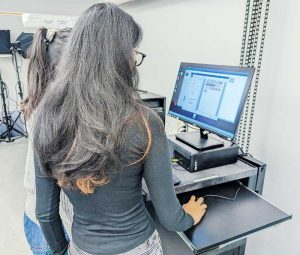
The curriculum incorporates large lectures, followed by smaller, hands-on lab sessions with groups of 25 to 30 students.
What are some of the other key components of your interdisciplinary program?
NL: One of the important components of our program is the opportunity for students to apply for paid corporate internships. In their third year, they can interview with companies from across Canada at our Career Fair. To facilitate as many opportunities as possible, we arrange a series of 12-minute interviews—similar to a “speed dating” situation. The support we have from our industry is really felt that day. The space is always full of energy. It’s a really fun day.
Many of our students receive offers for permanent employment from the firms they intern with. A few choose to do international internships in locations like Singapore or Australia. In addition to internships, we offer student exchanges with partners in countries all over the world, including South Korea, England, and Germany.
What features of your printing equipment are the most impactful?
Darsan Sivanantharajah (DS): The expanded colour gamut is a game changer compared to earlier technology. We are using CMYKLcLmOrGr inks, which fit our needs both in classrooms and with our faculty research goals. This ink setup also produces the ideal grey balance.
The media clamps have eliminated paper curls, the LED lights give access to verifying print quality while in production, and the ink cartridges on the front allow us to quickly determine the gamut, as well as swap cartridges for continuous production.
From a maintenance point of view, details such as LED lights to clean the undercarriage of the printheads are useful. Media loading and unloading is easy, and the liquid crystal display (LCD) control helps students to determine what media is loaded in the machine.
Overall, new technology is allowing our instructors to re-evaluate course design to increase student interaction with the equipment, which in turn allows them to gain a deeper understanding of what is possible with the combination of equipment in our labs.
Which wide-format applications are you teaching your students to print?
NL: We teach all of our first-year students to design decals, and then print and cut them. We’ve also done workshops where we’ve printed vinyl for Christmas ornaments, water bottles, and other fun applications. When we have new students who may be bright-eyed and bushy-tailed but are not really sure yet whether graphic communications management is the right choice, having them design and print their own stickers they can then apply on the back of their smartphones does wonders.
We also use our printer/cutter for the Sign and Display course, where students are taught to design, produce, and install window and floor graphics. We haven’t tackled vehicle graphics yet, but we have everything we need to begin doing so. In the next few months, I’m going to wrap my car to get us started on it.






Does Ryerson still teach offset printing?